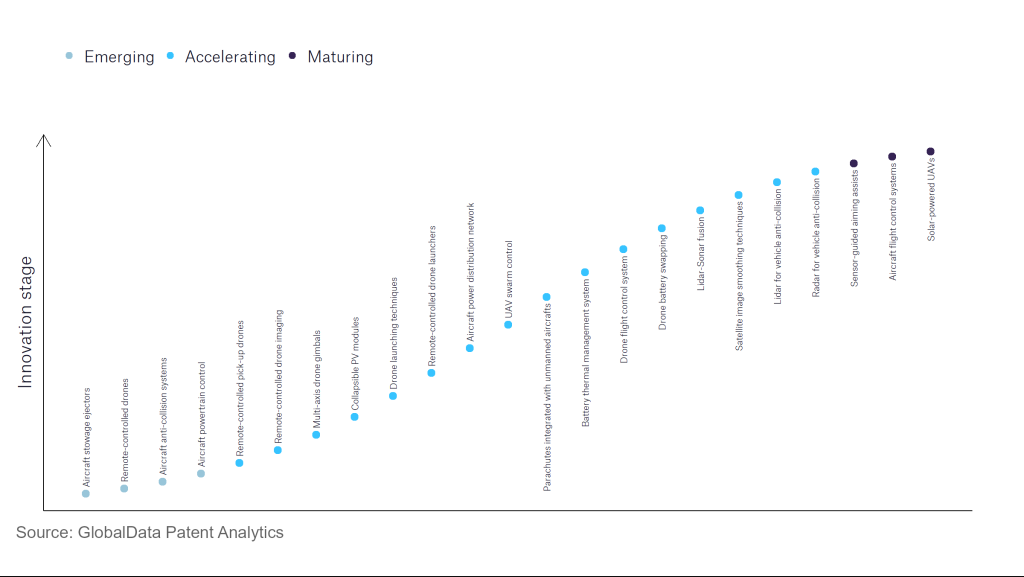The aerospace and defence industry continues to be a hotbed of innovation, with activity driven by the pressing need for modernisation and the growing importance of emerging technologies such as artificial intelligence and unmanned systems.
In the last three years alone, there have been over 174,000 patents filed and granted in the aerospace and defence industry, according to GlobalData’s report on Internet of Things in Aerospace, Defence & Security: remote-controlled pick-up drones.
However, not all innovations are equal and nor do they follow a constant upward trend. Instead, their evolution takes the form of an S-shaped curve that reflects their typical lifecycle from early emergence to accelerating adoption, before finally stabilising and reaching maturity.
Identifying where a particular innovation is on this journey, especially those that are in the emerging and accelerating stages, is essential for understanding their current level of adoption and the likely future trajectory and impact they will have.
180+ innovations will shape the aerospace and defence industry
According to GlobalData’s Technology Foresights, which plots the S-curve for the aerospace and defence industry using innovation intensity models built on over 262,000 patents, there are 180+ innovation areas that will shape the future of the industry.
Within the emerging innovation stage, aircraft powertrain controls, remote-controlled drones, and aircraft anti-collision systems are disruptive technologies that are in the early stages of application and should be tracked closely. UAV swarm control, lidar for vehicle anti-collision, and satellite image smoothing techniques are some of the accelerating innovation areas, where adoption has been steadily increasing. Among maturing innovation areas are sensor-guided aiming assists and aircraft flight control systems, which are now established in the industry.
Innovation S-curve for the aerospace and defence industry

Remote-controlled pick-up drones is a key emerging innovation area in Internet of Things
Remotely operated drones are commonly employed to enhance security at physical facilities and can be significantly less costly than human presence or expensive camera systems. Remotely operated drones can be used to secure military or industry sites as needed, while specialised pick-up drones are capable of moving physical objects and can be leveraged for commercial or military needs.
GlobalData’s analysis also uncovers the companies at the forefront of each innovation area and assesses the potential reach and impact of their patenting activity across different applications and geographies.
According to GlobalData, there are 30+ companies, spanning technology vendors, established aerospace and defence companies, and up-and-coming start-ups engaged in the development and application of remote-controlled pick-up drones.
Key players in remote-controlled pick-up drones – a disruptive innovation in the aerospace and defence industry
‘Application diversity’ measures the number of different applications identified for each relevant patent and broadly splits companies into either ‘niche’ or ‘diversified’ innovators.
‘Geographic reach’ refers to the number of different countries each relevant patent is registered in and reflects the breadth of geographic application intended, ranging from ‘global’ to ‘local’.
Patent volumes related to remote-controlled pick-up drones
The leading patent filer in the remote-controlled pick-up drones sector is Wing Aviation, a subsidiary of Alphabet which is currently developing several delivery solutions using pick-up drones.
The company’s objective is to develop sustainable and scalable delivery ecosystems for the commercial market. Boeing is another prominent patent filer in this field, having invested in UAVs with payload capacities of up to 500 pounds which are designed to have multiple military applications. Other key patent filers in the sector include Tevel Aerobotics Technologies, Rakuten Group and Hood Technology.
In terms of application diversity, Indutrade is one of the leaders, followed by Tevel Aerobotics Technologies and IBM. With regard to their geographic reach, Tevel Aerobotics Technologies and Pearls of Wisdom Advanced Technologies are the leading companies.
Whilst many companies are advancing this technology in order to facilitate cheaper and quicker delivery systems, the development of military pick-up drones by Boeing showcases that the technology is dual-use and commercial advances will likely have knock-on effects for the military market.
To further understand how the Internet of Things is disrupting the aerospace and defence industry, access GlobalData’s latest thematic research report on Thematic Research - Internet of Military Things.
GlobalData, the leading provider of industry intelligence, provided the underlying data, research, and analysis used to produce this article.
GlobalData’s Patent Analytics tracks patent filings and grants from official offices around the world. Textual analysis and official patent classifications are used to group patents into key thematic areas and link them to specific companies across the world’s largest industries.